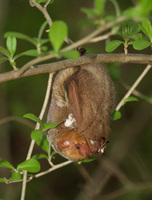
Although more than 1,000 species of bats are known to exist, only 14 species are found in West Virginia. These are the little brown bat, northern long-eared bat, Indiana bat (endangered), gray bat, small-footed bat, silver-haired bat, eastern pipistrelle, big brown bat, red bat, hoary bat, Seminole bat, evening bat, Virginia big-eared bat, and Rafinesque’s big-eared bat. Nearly 70 percent of the world’s bats feed on insects, as do all bats found in the Mountain State.
Most bats in the state use caves at some point in their lives. Many hibernate in caves where they find cool, humid environments that stay above freezing all winter. Here they can lower their metabolism to conserve energy. In this way, they can survive the winter on fat they accumulate in the fall before entering hibernation. Bats use an echo-location system to “see with their ears” and find their way in the dark.
The endangered Virginia big-eared bat is the only bat in the state which raises its young, called pups, in caves. Other bats gather in warm areas, such as attics or hollow trees, to rear their pups. Most bats give birth to only one pup each year. The pup grows rapidly and is able to fly by the time it is three to four weeks old. Bats are relatively long-lived for mammals their size; some have lived more than 30 years.
Tree bats do not use caves. They live in trees where they hide in the foliage or in cracks in the bark. Because they do not hibernate in caves, these species may migrate south to avoid the cold of winter. Tree bats found in West Virginia include the red bat, hoary bat (West Virginia’s largest bat), Seminole bat, and silver-haired bat.
White-Nose Syndrome is a condition that is killing cave-dwelling bats in the eastern United States. White-Nose Syndrome was first discovered in a cave near Albany, New York, in 2006. In 2009, it was found in four caves in Pendleton County. Since then, the condition has been discovered in bats in Grant, Greenbrier, Hardy, Jefferson, Mercer, Monroe, Nicholas, Pocahontas, Preston, Randolph, Tucker, and Wetzel counties, with suspected cases in Mineral and Monongalia counties. The syndrome appears to be caused by a cold-loving fungus that affects bats while they hibernate. Affected bats use up their fat reserves more quickly than normal and starve to death before winter is over and insects are available once again. Mortality rates of more than 90 percent have been reported at hibernation sites. The bats in West Virginia most devastated by White-Nose Syndrome are little brown bats (Myotis lucifugus), northern long-eared bats (Myotis septentrionalis), and tricolored bats (Perimyotis subflavus).
This Article was written by Craig W. Stihler
Last Revised on October 10, 2023
Related Articles
Sources
Barbour, R. W. & W. H. Davis. Bats of America. Lexington: University Press of Kentucky, 1969.
Harvey, Michael J. Bats of the Eastern U.S.. Little Rock: Arkansas Game & Fish Commission, 1992.
Tuttle, Merlin D. America's Neighborhood Bats. Austin: University of Texas Press, 1988.
Cite This Article
Stihler, Craig W. "Bats." e-WV: The West Virginia Encyclopedia. 10 October 2023. Web. 26 July 2024.


Comments?
There aren't any comments for this article yet.
Click here to read and contribute to the discussion →